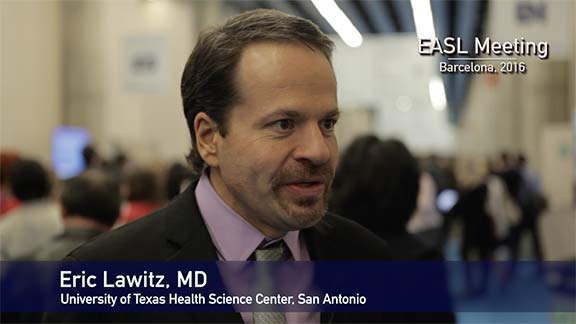
BARCELONA — An investigational drug combination offers renewed hope of a cure for chronic hepatitis C (HCV) patients who have tried and failed therapy with the new direct-acting antiviral agents, a researcher said here.
Cure rates with the new agents — sofosbuvir (Sovaldi), combined with velpatasvir and GS-9857 — are above 90%, but that means some patients still do not succeed in clearing the virus, according to Eric Lawitz, MD, of the University of Texas Health Science Center in San Antonio.
Velpatasvir is an NS5A inhibitor and GS-9857 is a novel inhibitor of the viral NS3/4A protease. The investigational combination was formulated into a single pill taken once a day and, in the study, was given with or without the nonspecific antiviral ribavirin, Lawitz explained to reporters at the International Liver Congress.
“The question is what to do we do with the few patients who do fail,” Lawitz said. The answer is likely to be “salvage” with new combinations of drugs, such as the one he presented here.
In a small phase II trial, the combination was both highly effective and safe, Lawitz said at a media briefing, and will go forward to a phase III study.
“It’s a small study but it’s the groundwork for an evolving field,” Lawitz said.
Despite the early stage of the research, the study was highlighted here because it’s a “nice example” of how the science of HCV treatment is moving into a new phase, commented Tom Hemming Karlsen, MD, PhD, of the Oslo University Hospital and vice-secretary of the European Association of the Study of the Liver (EASL), which organizes the meeting.
“We do see a need for treatments for this fraction of patients” who fail to clear the virus with the first generation agents, he told MedPage Today.
The study is among the first to have data on the “second generation” of drugs and drug combinations, Karlsen said.
Lawitz and colleagues enrolled 49 patients with genotype 1 HCV who had previously been treated for at least 6 weeks with any of the direct-acting agents but who had not been cured. A cure was defined as SVR12 — no detectable HCV RNA 12 weeks after the end of therapy.
About half the patients had compensated cirrhosis, he said.
They were treated for 12 weeks with the investigational combination in an open-label uncontrolled fashion, with 25 patients randomly assigned to get ribavirin, and then followed for another 12 weeks. The primary endpoint was SVR12.
Overall, only one patient — in the ribavirin arm — relapsed and the remainder achieved an SVR12, Lawitz said. Since very few patients relapse after an SVR12, it is regarded as a cure.
The addition of ribavirin to the combination appeared to have no effect on efficacy and will be dropped in the phase III study, he said.
About half of the patients reported adverse events, with a preponderance in the ribavirin arm, Lawitz said. The only grade 3 adverse event was a rash that afflicted a patient in the ribavirin arm; rash is a known side effect of ribavirin and the drug was stopped, he said.
Anemia is another known side effect of ribavirin, and six patients in the ribavirin arm saw their hemoglobin levels drop below 10 g/dL, with two of those falling below 8.5 g. The effect wasn’t seen among patients in the other arm, Lawitz reported.
In essence, he said, ribavirin added nothing to efficacy but did increase the toll of adverse events.
Importantly, viral resistance-associated variants that had emerged during earlier treatment had no effect on therapy with the new combination.
“When we have patients who fail we need salvage options [that can] cure everyone we see, with the right armamentarium of agents,” Lawitz concluded.
Source: Combo Tx Offers ‘Salvage’ in Tough-to-Treat HCV | Medpage Today






